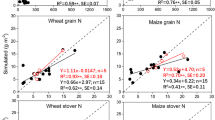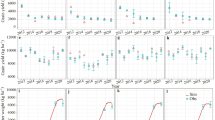Abstract
Climate change affects the established crop production practices by altering rainfall, temperature, and solar radiation—leading to reduced resource use and economic efficiencies. Pertaining to this, we analysed the optimum fertiliser-Nitrogen (N) recommendation of rice and wheat crops for Kharagpur station, West Bengal, India under projected climate change conditions by using six mathematical models, namely, quadratic, square root, linear plateau, quadratic plateau, square root plateau, and the Mitscherlich model. Models were parameterised using field experiment observations at Kharagpur and tested for historical crop yield. The historical (1976–2005) and future (2006–2100) yield responses of rice and wheat to the different N doses are simulated by using a calibrated and validated process-based crop simulation model—Crop Environment and Resource Synthesis (CERES). Eight bias-corrected Global Climate Model (GCM) outputs for the four Representative Concentration Pathways (RCP2.6, RCP4.5, RCP6.0, and RCP8.5) were used to simulate the yield of both crops for the period of 1976 to 2100. Results revealed that the quadratic plateau model represents crop yield response to fertiliser-N application better than other mathematical models. The estimated optimum N dose (OND) increased from an average historical 121 kg N/ha to 138, 143, and 146 kg N/ha for rice, and from an average historical 98 kg N/ha to 119, 124, and 127 kg N/ha for wheat in three future times, respectively, 2006–2035, 2036–2065, and 2066–2095 under all RCPs scenarios. On the other hand, the yield of both crops is expected to decrease in the future due to an increase in N losses, leading to reduced N use efficiency.








Similar content being viewed by others
Data availability
The field experiment datasets collected and/or analysed during the current study are available from the corresponding author upon reasonable request.
Code availability
Crop simulation model DSSAT is available to download from dssat.net; and fertiliser optimization programs, written in MATLAB, are available on reasonable request.
References
Ahmad MJ, Choi K-S, Cho G-H, Kim S-H (2019) Future wheat yield variabilities and water footprints based on the yield sensitivity to past climate conditions. Agronomy 9(11):744. https://doi.org/10.3390/agronomy9110744
Alivelu K, Srivastava S, Subba Rao A, Singh KN, Selvakumari G, Raju NS (2003) Comparison of Modified Mitscherlich and Response Plateau Models for Calibrating Soil Test Based Nitrogen Recommendations for Rice on Typic Ustropept. Commun Soil Sci Plant Anal 34(17–18):2633–2643. https://doi.org/10.1081/CSS-120024790
Alivelu K, Rao AS, Sanjay S, Singh KN, Raju NS, Madhuri P (2006) Prediction of optimal nitrogen application dose of rice based on soil test values. Eur J Agron 25(1):71–73. https://doi.org/10.1016/j.eja.2005.10.011
Asseng S, Ewert F, Martre P, Rötter RP, Lobell DB, Cammarano D, Kimball BA, Ottman MJ, Wall GW, White JW, Reynolds MP, Alderman PD, Prasad PVV, Aggarwal PK, Anothai J, Basso B, Biernath C, Challinor AJ, De Sanctis G et al (2015) Rising temperatures reduce global wheat production. Nat Clim Change 5(2):143–147. https://doi.org/10.1038/nclimate2470
Barlow KM, Christy BP, O’leary GJ, Riffkin PA, Nuttall JG (2015) Simulating the impact of extreme heat and frost events on wheat crop production: A review. Field Crops Res 171:109–119. https://doi.org/10.1016/j.fcr.2014.11.010
Belanger G, Walsh JR, Richards JE, Milburn PH, Ziadi N (2000) Comparison of three statistical models describing potato yield response to nitrogen fertiliser. Agron J 92(5):902–908. https://doi.org/10.2134/agronj2000.925902x
Boldea M, Sala F, Crista F (2011) Optimization of the chemical fertiliser dose for production benefit maximization. Res J Agric Sci 43(3):31–34
Bullock DG, Bullock DS (1994) Quadratic and quadratic-plus- plateau models for predicting optimal nitrogen dose of corn: A comparison. Agron J 86:191–195. https://doi.org/10.2134/agronj1994.00021962008600010033x
Caliao ND, Zahedi A (2000) Statistical modeling of radiation and wind speed for PV/wind hybrid system. In: Proceedings of the 38th annual conference of the Australian and New Zealand solar energy society (ANZSES) - Solar 2000. Griffith University, Brisbane
Cerrato ME, Blackmer AM (1990) Comparison of models for describing; corn yield response to nitrogen fertiliser. Agron J 82(1):138–143. https://doi.org/10.2134/agronj1990.00021962008200010030x
Colwell JD (1994) Estimating fertiliser requirements. A quantitative approach. CAB International, Wallingford, UK
Cressie NAC (1991) Statistics for spatial data. Wiley, New York, USA
Dubey M, Mishra A, Singh R (2021) Climate change impact analysis using bias-corrected multiple global climate models on rice and wheat yield. J Wat Cli Change 12(4):1282–1296. https://doi.org/10.2166/wcc.2020.191
FAO (2005) Fertilizer use by Crop in India Document Prepared by Land and Plant Nutrition Management Service, Land and Water Development Division. Food and Agriculture Organization of the United Nations, Rome, Italy. http://www.fao.org/3/a-a0257e.pdf. Accessed 23 Nov 2023
Grant C (2006) Enhancing nitrogen use efficiency in dry land cropping systems on the Northern Great Plains. In: Abstract proceedings of the- 18th world congress of soil science, Philadelphia
Gupta R, Mishra A (2019) Climate change induced impact and uncertainty of rice yield of agro-ecological zones of India. Agric Syst 173:1–11
He W, Yang JY, Qian B, Drury CF, Hoogenboom G, He P, Lapen D, Zhou W (2018) Climate change impacts on crop yield, soil water balance and nitrate leaching in the semiarid and humid regions of Canada. PLoS ONE 13(11):e0207370. https://doi.org/10.1371/journal.pone.0207370
Heffer P, Prud’homme M (2016) Global nitrogen fertiliser demand and supply: Trend, current level and outlook. In: International nitrogen initiative conference. Melbourne, Australia proceedings of the- international nitrogen initiative conference, “solutions to improve nitrogen use efficiency for the world”, Melbourne
Hoogenboom G, Jones JW, Wilkens PW, Porter CH, Boote KJ, Hunt LA, Singh U, Lizaso JL, White JW, Uryasev O, Royce FS, Ogoshi R, Gijsman AJ, Tsuji GY, Koo J (2012) Decision Support System for agrotechnology transfer (DSSAT) version 4.5. University of Hawaii, Honolulu, Hawaii
Hoogenboom G, Jones JW, Boote KJ (1991) A decision support system for prediction of crop yield, evapotranspiration, and irrigation management. In: Irrigation and drainage. Proceedings of the 1991 national conference sponsored by the irrigation and drainage division of the American society of civil engineers and the Hawaii section, ASCE, Honolulu, Hawaii, 1991. ASCE, New York, NY, pp 198–204
IPCC (2013) Climate change 2013: The physical science basis. in contribution of working group I to the fifth assessment report of the intergovernmental panel on climate change. In: Stocker TF, Qin D, Plattner G-K, Tignor M, Allen SK, Boschung J, Nauels A, Xia Y, Bex V, Midgley PM (eds). Cambridge University Press, Cambridge, UK and New York, NY, p 1535
Ines AV, Hansen JW (2006) Bias correction of daily GCM rainfall for crop simulation studies. Agric Meteorol 138(1):44–53. https://doi.org/10.1016/j.agrformet.2006.03.009
Jabloun M, Schelde K, Tao F, Olesen JE (2015) Effect of temperature and precipitation on nitrate leaching from organic cereal cropping systems in Denmark. Eur J Agron 62:55–64. https://doi.org/10.1016/j.eja.2014.09.007
Jones JW, Hoogenboom G, Porter CH, Boote KJ, Batchelor WD, Hunt LA, Wilkens PW, Singh U, Gijsman AJ, Ritchie JT (2003) DSSAT cropping system model. Eur J Agron 18:235–265. https://doi.org/10.1016/S1161-0301(02)00107-7
Kamruzzaman M, Hwang S, Choi SK, Cho J, Song I, Jeong H, Song JH, Jang T, Yoo SH (2020) Prediction of the effects of management practices on discharge and mineral nitrogen yield from paddy fields under future climate using APEX-paddy model. Agric Water Manag 241:106345. https://doi.org/10.1016/j.agwat.2020.106345
Kaur H, Ram H (2017) Nitrogen management of wheat cultivars for higher productivity-A review. J Appl Nat Sci 9(1):133–143
Korzukhin MD, Ter-Mikaelian MT, Wagner RG (1996) Process versus empirical models: which approach for forest ecosystem management? Can J For Res 26(5):879–887. https://doi.org/10.1139/x26-096
Kumar LP, Indira M (2017) Trends in fertiliser consumption and food grain production in India: a co-integration analysis. SDMIMD J Manag 8(2):45–50. https://doi.org/10.18311/sdmimd/2017/18025
Kundu A, Dwivedi S, Chandra V (2014) Precipitation trend analysis over eastern region of India using CMIP5 based climatic models. The International Archives of Photogrammetry, Remote Sensing and Spatial Information Sciences 40:1437–1442. https://doi.org/10.5194/isprsarchives-XL-8-1437-2014
Kyveryga PM, Blackmer AM, Morris TF (2007) Alternative benchmarks for economically optimal doses of nitrogen fertilization for corn. Agron J 99(4):1057–1065. https://doi.org/10.2134/agronj2006.0340
Kyveryga PM, Blackmer AM, Morris TF (2007) Disaggregating model bias and variability when calculating economic optimum doses of nitrogen fertilization for corn. Agron J 99(4):1048–1056. https://doi.org/10.2134/agronj2006.0339
Lobell DB, Ortiz-Monasterio JI (2006) Evaluating strategies for improved water use in spring wheat with CERES. Agric Water Manag 84(3):249–258. https://doi.org/10.1016/j.agwat.2006.02.007
Maqsood M, Shehzad MA, Ramzan Y, Sattar A (2014) Effect of nitrogen nutrition on growth, yield and radiation use efficiency of different wheat (Triticumaestivum L.) cultivars. Pak J Agric Sci 51(2):441–448
Marschner H (1995) Mineral nutrition of higher plants, 2nd edn. Academic Press Ltd, London, p 889. https://doi.org/10.1016/B978-0-12-473542-2.X5000-7
McCarthy WO (1959) Production function analysis of a fertiliser trial on barley. Aust J Agric Econ 3(429-2016–29273):1–11. https://doi.org/10.22004/ag.econ.22537
Miao Y, Mulla DJ, Batchelor WD, Paz JO, Robert PC, Wiebers M (2006) Evaluating management zone optimal nitrogen rates with a crop growth model. Agron J 98(3):545–553. https://doi.org/10.2134/agronj2005.0153
Mishra A, Singh R, Raghuwanshi NS, Chatterjee C, Froebrich J (2013) Spatial variability of climate change impacts on yield of rice and wheat in the Indian Ganga basin. Sci Total Environ 468–469:S132–S138. https://doi.org/10.1016/j.scitotenv.2013.05.080
Mitscherlich EA (1909) The law of the minimum and the law of diminishing soil productivity (in German). Landwirtsch Jahrb 38:537–552
Patil RH, Laegdsmand M, Olesen JE, Porter JR (2012) Sensitivity of crop yield and N losses in winter wheat to changes in mean and variability of temperature and precipitation in Denmark using the FASSET model. Acta Agric Scand Sec B-Soil Plant Sci 62(4):335–351. https://doi.org/10.1080/09064710.2011.615758
Paz JO, Batchelor WD, Babcock BA, Colvin TS, Logsdon SD, Kaspar TC, Karlen DL (1999) Model-based technique to determine variable rate nitrogen for corn. Agric Syst 61(1):69–75. https://doi.org/10.1016/S0308-521X(99)00035-9
Piani C, Weedon GP, Best M, Gomes SM, Viterbo P, Hagemann S, Haerter JO (2010) Statistical bias correction of global simulated daily precipitation and temperature for the application of hydrological models. J Hydrol 395(3):199–215. https://doi.org/10.1016/j.jhydrol.2010.10.024
Rajsic P, Weersink A (2008) Do farmers waste fertiliser? A comparison of ex post optimal nitrogen doses and ex ante recommendations by model, site and year. Agric Syst 97(1–2):56–67. https://doi.org/10.1016/j.agsy.2007.12.001
Sala F, Boldea M, Rawashdeh H, Nemet I (2015) Mathematical model for determining the optimal doses of mineral fertilisers for wheat crops. Pak J Agric Sci 52(3):609–617
Wada Y, Wisser D, Eisner S, Flörke M, Gerten D, Haddeland I, Hanasaki N, Masaki Y, Portmann FT, Stacke T, Tessler Z, Schewe J (2013) Multimodel projections and uncertainties of irrigation water demand under climate change. Geophys Res Let 40:4626–4632. https://doi.org/10.1002/grl.50686
Watkins KB, Hignight JA, Norman RJ, Roberts TL, Slaton NA, Wilson CE, Frizzell DL (2010) Comparison of economic optimum nitrogen doses for rice in Arkansas. Agron J 102(4):1099–1108. https://doi.org/10.2134/agronj2009.0497
Watterson IG, Dix MR (2003) Simulated changes due to global warming in daily precipitation means and extremes and their interpretation using the gamma distribution. Journal of Geophysical Research: Atmospheres 108(D13):4379. https://doi.org/10.1029/2002JD002928
Wilks DS (2006) Statistical methods in the atmospheric sciences. International Geophysics Series, 2nd edn. Elsevier Academic, San Diego, CA
Willmott CJ (1982) Some comments on the evaluation of model performance. Bull Am Meteor Soc 63(11):1309–1313. https://doi.org/10.1175/1520-0477(1982)063%3c1309:SCOTEO%3e2.0.CO;2
Funding
This work is partially supported by the project—Centre of Excellence (CoE) in Climate Change Studies established at IIT Kharagpur and funded by the Department of Science and Technology (DST), Government of India under Climate Change Programme (SPLICE).
Author information
Authors and Affiliations
Contributions
Ashok Mishra conceptualized and supervised this study. Field experiments and data collection and analysis were performed by Madhuri Dubey. The first draft of the manuscript was written by Madhuri Dubey which was rigorously corrected by Ashok Mishra and Rajendra Singh. All authors read and approved the final manuscript.
Corresponding author
Ethics declarations
Ethics approval and consent to participate
Not applicable as the study does not involve human participants, their data, or biological material.
Consent for publication
Not applicable.
Competing interests
The authors declare no competing interests.
Additional information
Publisher's Note
Springer Nature remains neutral with regard to jurisdictional claims in published maps and institutional affiliations.
Supplementary Information
Below is the link to the electronic supplementary material.
Rights and permissions
Springer Nature or its licensor (e.g. a society or other partner) holds exclusive rights to this article under a publishing agreement with the author(s) or other rightsholder(s); author self-archiving of the accepted manuscript version of this article is solely governed by the terms of such publishing agreement and applicable law.
About this article
Cite this article
Dubey, M., Mishra, A. & Singh, R. Climate change effect on optimal N recommendation and yield of rice and wheat crops. Theor Appl Climatol 155, 4049–4064 (2024). https://doi.org/10.1007/s00704-024-04866-1
Received:
Accepted:
Published:
Issue Date:
DOI: https://doi.org/10.1007/s00704-024-04866-1




